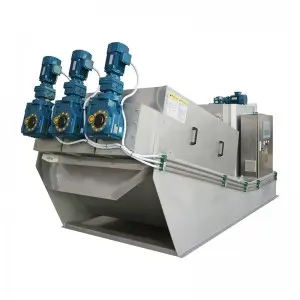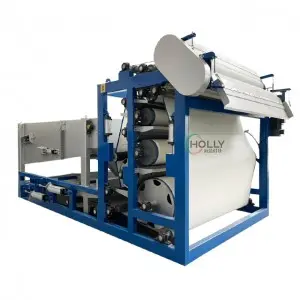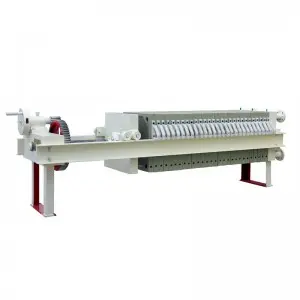Technical principle
1. New separation technology: The organic combination of spiral pressure and static and static ring has formed a new separation technology integrating concentration and dehydration, adding an advanced dehydration mode choice for the field of environmental protection sewage treatment in China.
The low speed operation of the main spiral shaft (3-5 RPM) reduces the mechanical wear of the equipment and prolongs the service life of the equipment. Main machine power consumption ≦1.1kw/hr, single power saving of 50,000 degrees/year.
3. Double the processing capacity: the second generation dehydrator has twice the processing capacity of the first generation dehydrator. A 303 unit can solve the sludge volume generated by 10,000 tons of sewage (120-150 tons) and can design a process of deep dewatering of sludge to 50-40%, and a single set of processes can solve the sewage treatment capacity of 1-30,000 tons.
4. The first in China: the pressure regulator adopts elastic automatic adjustment, which naturally balances the pressure rise in the sludge in the dewatering section, and more effectively ensures the service life of the dynamic and static ring plate.
5. Green environmental protection: the whole machine is sealed, and can be directly observed, the shell is convenient to disassemble and assemble, no sewage leakage, no secondary pollution, noise ≦45 decibels, so that the sludge room environment is beautiful and civilized production.
Ring type sludge dewatering machine without filter cloth filter hole and other blocking elements: safe and simple operation, according to the customer's operation period. Combined with the automatic control system, the program can be set to achieve automatic unattended (should have a considerable amount of sludge).
How it works edit
1, plate and frame sludge dewatering machine: in a closed state, the sludge driven by high pressure pump is squeezed through the plate and frame, so that the water in the sludge is discharged through the filter cloth to achieve the purpose of dehydration.
2, belt sludge dewatering machine: by the upper and lower two tensioned filter belt entrain the sludge layer, from a series of regular arrangement of roller cylinder in an S-shape through, relying on the tension of the filter belt itself to form the press and shear force of the sludge layer, the sludge layer in the capillary water squeezed out, so as to achieve sludge dehydration.
3, centrifugal sludge dewatering machine: by the transfer and with a hollow shaft of the spiral conveyor, the sludge is fed into the drum by the hollow shaft, under the centrifugal force generated by high-speed rotation, the production is thrown into the drum cavity. Due to the different specific gravity, solid-liquid separation is formed. The sludge is transported to the cone end of the drum under the push of the screw conveyor and discharged continuously from the outlet. The liquid in the liquid ring layer is discharged by continuous "overflow" from the weir mouth to the outside of the drum by gravity.
4, stacked sludge dewatering machine: by the fixed ring, the floating ring layer superimposed on each other, the spiral shaft through which the formation of the main filter. The sludge is fully dehydrated through gravity concentration and the internal pressure formed by the back pressure plate during the process of propulsion. The filtrate is discharged from the filter gap formed by the fixed ring and the movable ring, and the mud cake is discharged from the end of the dewatering part.
Related products:
Post time: Sep-07-2023




